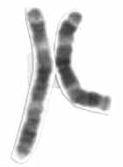3q29 microdeletion syndrome
| 3q29 microdeletion syndrome | |
|---|---|
| Synonyms | 3qter deletion, Monosomy 3q29 |
 |
|
| Chromosome 3 is associated with this condition | |
| Classification and external resources | |
| ICD-10 | Q93.5 |
| OMIM | 609425 |
| Orphanet | 65286 |
3q29 microdeletion syndrome is a rare genetic disorder resulting from the deletion of a segment of chromosome 3. This syndrome was first described in 2005.
The clinical phenotype of 3q29 microdeletion syndrome is variable. Clinical features can include mild/moderate mental retardation with mildly dysmorphic facial features (long and narrow face, short philtrum and a high nasal bridge). Of the 6 reported patients, additional features including autism, ataxia, chest-wall deformity and long, tapering fingers were found in at least two patients. A review of 14 children with insterstitial deletions of 3q29, found 11 who had the common recurrent 1.6Mb deletion and displayed mental retardation and microcephaly.
The variability of phenotype is underscored by the report on a 6 and 9/12 year-old male patient with a de novo chromosome 3q29 microdeletion identified by BAC array comparative genomic hybridization assay (aCGH), with accompanying normal 46,XY high-resolution chromosome analysis. The patient has language-based learning disabilities and behavioral features consistent with diagnoses of autism and attention deficit hyperactivity disorder (ADHD) of the inattentive type. He also displays some other features previously associated with chromosome 3q29 microdeletion such as an elongated face, long fingers, and joint laxity. Most notably the patient, per formal IQ testing, was not found to have frank mental retardation as has been previously reported among patients with chromosome 3q29 terminal deletion, but rather the patient has demonstrated an average full-scale IQ result. This report further expands the phenotypic spectrum to include the possibility of normal intelligence as corroborated by formal, longitudinal psycho-educational testing.
The presence of two homologous low copy repeats either side of the deletion break-point suggests that non-allelic homologous recombination is the likely mechanism underlying this syndrome.
...
Wikipedia
